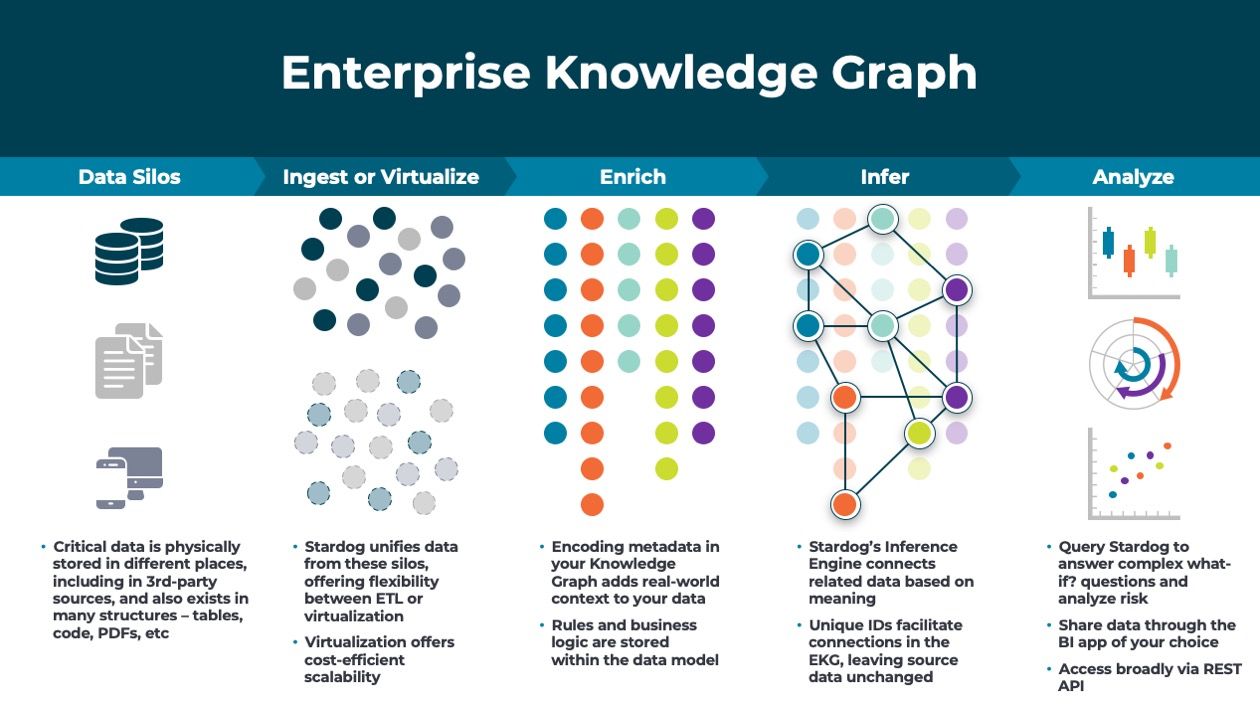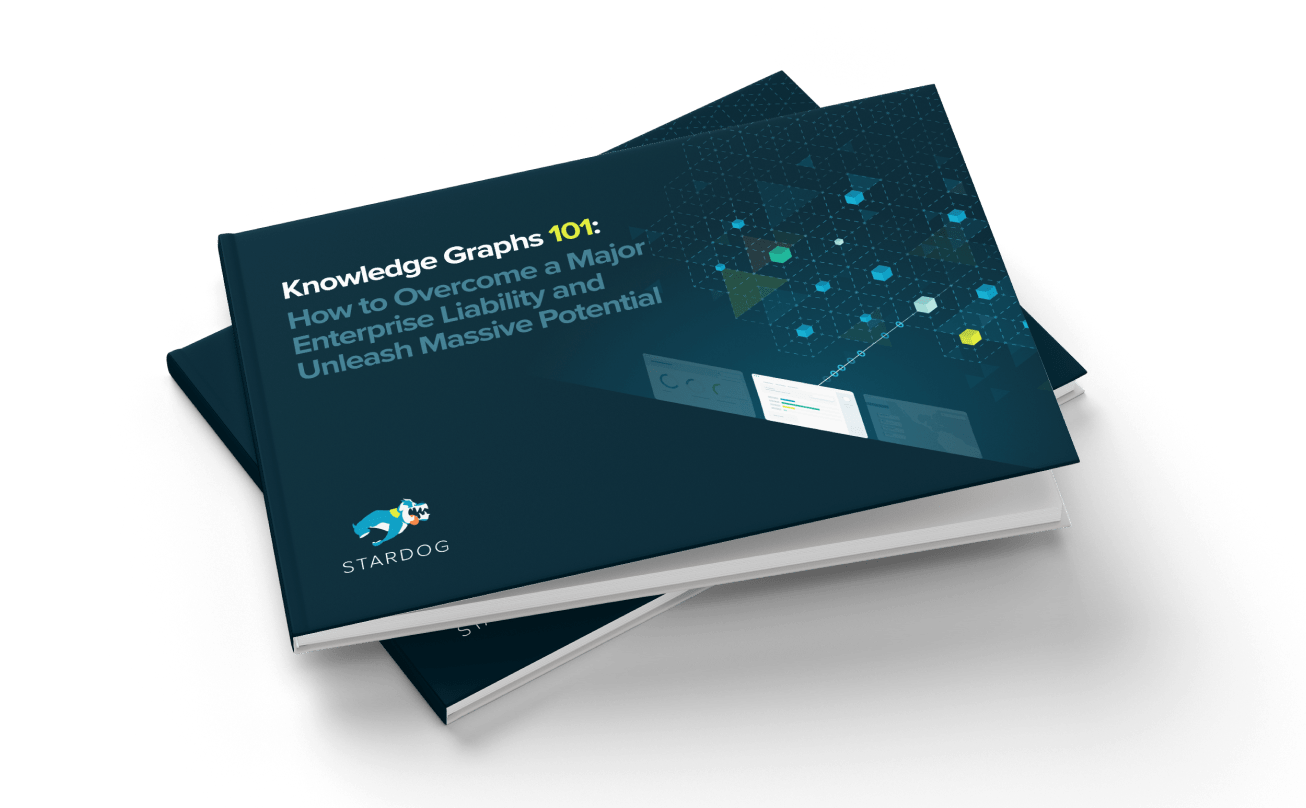Create your Digital Twin with an Enterprise Knowledge Graph

Get the latest in your inbox

Get the latest in your inbox
In the mid-spring of 2020, deep into the pandemic’s first phase, Satya Nadella, Microsoft’s CEO, said that we’ve seen “two years of digital transformation in two months.” The move to remote work, dramatically shifting consumer behavior, and reprioritized budgets have challenged companies and shocked transformation into life. The pandemic has underscored a truth of enterprise data management: moving your business fully “online” is critical to longterm business health.
So what is involved in moving business fully online? The key is a single, aggressively simple insight: (1) you need a model of your business, that’s (2) distinct from analytics and algorithms, which can (3) be used to unify the data of your business. Put a more pithily: the map is not the territory, and it never will be, but you still need a map!
A systematic “digital twin” serves as that map, replicating the people, places, and things relevant to your business in a digital model. Functionally, this requires that each key data entity, relationship, business process, and functional organizational unit of the enterprise — or, more generically, every thing that you actually want to manage — has a corresponding proxy or stand-in within the digital realm. It’s the programmatic, algorithmic manipulation of those stand-ins or proxies that is the way of digital transformation. Quite simply, a digital twin accurately represents your org, in all its complexity.
Digital twin emerged as a goal alongside the Internet of Things (IoT). Sensor data is transforming our ability to monitor and manage physical things dispersed across the globe. Cars are now computers on wheels, constantly sending signal data like location, speed, and time to destination.
First espoused by manufacturers for product lifecycle management before expanding to factory floor digitization and supply chain, I’m now hearing digital twin crop up in conversations with leading banks and insurers desiring a more complete view of their organization. Whereas gaining a 360°-view of customers and products has long been the goal of MDM, digital twin is more expansive: it’s digital, dynamic, and diverse.
Where does digital twin go from here? A digital twin must already be able to represent hundreds of millions of relationships and rules. I predict that digital twins will continue to merge with more and more data sources from across the organization. This will be driven by an increasing desire to gain more granular understanding of the business process being digitized. And with greater volumes, and varying sources, comes greater complexity. Gartner nails this point:
“When combining the twin data with business rules, optimization algorithms or other prescriptive analytics technologies, digital twins can support human decisions or even automate decision making. For example, a capability of the digital twin of a truck could be to track the state of the brakes. Current and historical data in the twin will provide the estimated time for the next needed maintenance, which the maintenance system can use to schedule at the optimal time.”
- Smarter With Gartner, “How Digital Twins Simplify the IoT.”
The need for automated control systems will only increase as businesses seek greater efficiencies in pursuit of market advantage. Hyperautomation is coming! Everyone wants to do less work; even better: make the machines do the work for you. Whatever system is managing business rules must be capable of handling complex logic and situational decision-making, as well as serving as an interoperable connective tissue across the organization.
So what kind of model do you need to achieve an effective digital twin? One that can support exponential data volumes, complex logic, and automated control systems? In my view the model of your business must be:
It should be a composable, machine-understandable representation of the key entities and relationships, as well as business logic and rules, that describe or govern the key business processes of your enterprise. Ironically, there are already models of your business all over your enterprise. But they are partial, fragmentary, specific to some analytics or computation system, and, crucially, inseparable from particular software systems. Which is just to say that they exist but aren’t expressive, extensible, agile, or separable from computation.
In short, they’re an existence proof that such a thing can and does exist, but beyond that they’re not much help with respect to accomplishing digital twin.
To succeed with a digital twin strategy, you need a machine-understandable model of the business. That’s where an Enterprise Knowledge Graph platform like Stardog comes into play.
Stardog supports modeling the enterprise with an expressive, extensible data model based on semantic graphs. Stardog’s Inference Engine allows you to harmonize conflicting data definitions without changing, moving, or even copying the underlying data. Capture your business and domain rules in the data model; the Inference Engine intelligently applies these rules at search and at query time. Using a unique data virtualization capability, Stardog performs this on existing enterprise data where it lives, avoiding expensive or pointless data copying and data movement.
Stardog’s native semantic graph capabilities connect enterprise data based on meaning rather than location. Now, for the first time, there is a connected network of business meaning independent of any particular silo or analytics or computational application. As a result, your Knowledge Graph will fundamentally enable greater interoperability and exchange of data.

Stardog creates a digital twin through a single, virtualized data access layer, unifying data from silos across your organization, and exposing data through a REST API, BI tools, or custom apps.
How is this possible? At its core, Stardog is built on a family of W3C open standards for knowledge representation. This family of open standards is designed to make information machine-understandable and composable. Stardog easily handles different standards and terminology, keeping legacy systems in place while allowing for dialects. This is accomplished through assigning each data object a unique ID, to which all related information is linked. Data owners can maintain control while providing shared access through the unique ID. All this connected data together forms a single, virtualized data access layer to support the digital twin strategy of your enterprise.
I know what you’re thinking now: fine, that sounds great, but how can we at Big Bank or Big Retailer get that done in a reasonable time at reasonable level of investment? Where do we start?
Here’s what we’ve learned at Stardog:
Stardog customers are starting small, iterating, and creating digital twins for significant parts of their enterprise. They are deploying digital twins in varying use cases, from supply chain to smart buildings. Increasingly Stardog customers are, in their second and third use cases, starting to join data up to initial use cases, which lowers incremental costs and compounds business value.
Our approach to Stardog as a product and our world-class professional services team aligns our customers fully with this approach. We’re here to help you move your business online via a centralized, accessible, and expressive data model of your organization, in all its complexity.
Give us a call and we’ll help you build the future, too.
How to Overcome a Major Enterprise Liability and Unleash Massive Potential
Download for free